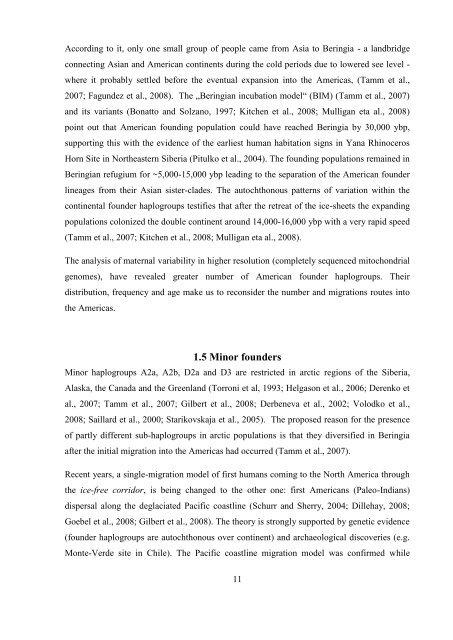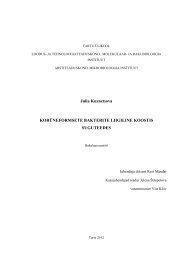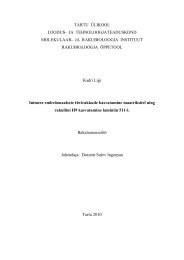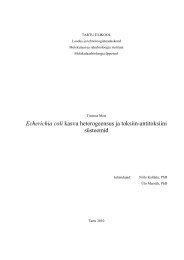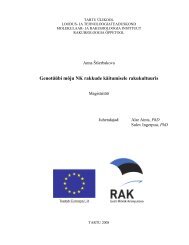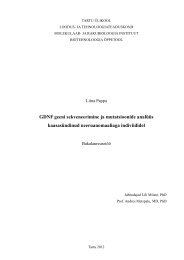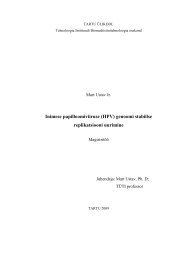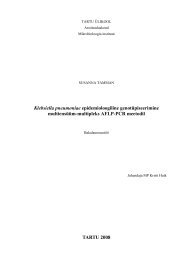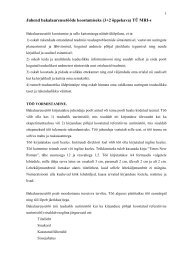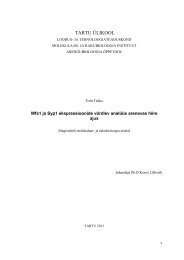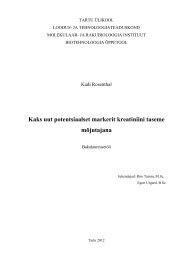Maternal variation in Huichol and Mixtec populations from Mexico
Maternal variation in Huichol and Mixtec populations from Mexico
Maternal variation in Huichol and Mixtec populations from Mexico
You also want an ePaper? Increase the reach of your titles
YUMPU automatically turns print PDFs into web optimized ePapers that Google loves.
Accord<strong>in</strong>g to it, only one small group of people came <strong>from</strong> Asia to Ber<strong>in</strong>gia - a l<strong>and</strong>bridge<br />
connect<strong>in</strong>g Asian <strong>and</strong> American cont<strong>in</strong>ents dur<strong>in</strong>g the cold periods due to lowered see level -<br />
where it probably settled before the eventual expansion <strong>in</strong>to the Americas, (Tamm et al.,<br />
2007; Fagundez et al., 2008). The „Ber<strong>in</strong>gian <strong>in</strong>cubation model“ (BIM) (Tamm et al., 2007)<br />
<strong>and</strong> its variants (Bonatto <strong>and</strong> Solzano, 1997; Kitchen et al., 2008; Mulligan eta al., 2008)<br />
po<strong>in</strong>t out that American found<strong>in</strong>g population could have reached Ber<strong>in</strong>gia by 30,000 ybp,<br />
support<strong>in</strong>g this with the evidence of the earliest human habitation signs <strong>in</strong> Yana Rh<strong>in</strong>oceros<br />
Horn Site <strong>in</strong> Northeastern Siberia (Pitulko et al., 2004). The found<strong>in</strong>g <strong>populations</strong> rema<strong>in</strong>ed <strong>in</strong><br />
Ber<strong>in</strong>gian refugium for ~5,000-15,000 ybp lead<strong>in</strong>g to the separation of the American founder<br />
l<strong>in</strong>eages <strong>from</strong> their Asian sister-clades. The autochthonous patterns of <strong>variation</strong> with<strong>in</strong> the<br />
cont<strong>in</strong>ental founder haplogroups testifies that after the retreat of the ice-sheets the exp<strong>and</strong><strong>in</strong>g<br />
<strong>populations</strong> colonized the double cont<strong>in</strong>ent around 14,000-16,000 ybp with a very rapid speed<br />
(Tamm et al., 2007; Kitchen et al., 2008; Mulligan eta al., 2008).<br />
The analysis of maternal variability <strong>in</strong> higher resolution (completely sequenced mitochondrial<br />
genomes), have revealed greater number of American founder haplogroups. Their<br />
distribution, frequency <strong>and</strong> age make us to reconsider the number <strong>and</strong> migrations routes <strong>in</strong>to<br />
the Americas.<br />
1.5 M<strong>in</strong>or founders<br />
M<strong>in</strong>or haplogroups A2a, A2b, D2a <strong>and</strong> D3 are restricted <strong>in</strong> arctic regions of the Siberia,<br />
Alaska, the Canada <strong>and</strong> the Greenl<strong>and</strong> (Torroni et al, 1993; Helgason et al., 2006; Derenko et<br />
al., 2007; Tamm et al., 2007; Gilbert et al., 2008; Derbeneva et al., 2002; Volodko et al.,<br />
2008; Saillard et al., 2000; Starikovskaja et al., 2005). The proposed reason for the presence<br />
of partly different sub-haplogroups <strong>in</strong> arctic <strong>populations</strong> is that they diversified <strong>in</strong> Ber<strong>in</strong>gia<br />
after the <strong>in</strong>itial migration <strong>in</strong>to the Americas had occurred (Tamm et al., 2007).<br />
Recent years, a s<strong>in</strong>gle-migration model of first humans com<strong>in</strong>g to the North America through<br />
the ice-free corridor, is be<strong>in</strong>g changed to the other one: first Americans (Paleo-Indians)<br />
dispersal along the deglaciated Pacific coastl<strong>in</strong>e (Schurr <strong>and</strong> Sherry, 2004; Dillehay, 2008;<br />
Goebel et al., 2008; Gilbert et al., 2008). The theory is strongly supported by genetic evidence<br />
(founder haplogroups are autochthonous over cont<strong>in</strong>ent) <strong>and</strong> archaeological discoveries (e.g.<br />
Monte-Verde site <strong>in</strong> Chile). The Pacific coastl<strong>in</strong>e migration model was confirmed while<br />
11


